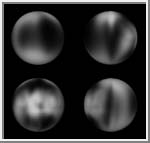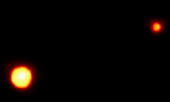













|
Copyright © 1998 by Rosanna L. Hamilton. All rights reserved.
James W. Christy, a U.S. Naval Observatory scientist, was studying plates to refine our knowledge of Plutoís orbit and position, when the discovery of Charon was made. The discovery image of Charon and Pluto was taken on July 2, 1978. The new satellite was named after the ferryman who rowed souls across the River Styx to Plutoís realm in the underworld of Greek and Roman mythology. Charon is informally pronounced "SHAR-on," similar to the name of the discovererís wife, Charlene.
The 1978 discovery of Plutoís satellite, Charon, was a breakthrough in gaining understanding of Pluto. By measuring the distance between the two and knowing the orbital period, it was possible to calculate for their mass. Charonís mass is about 9.6 x 10-10 solar masses. This is about 1/7th the mass of Pluto.
During the 1980ís, Earth crossed the orbital plane of Charon and a series of mutual events were observed that significantly enhanced the study of the Pluto-Charon system. It was fortunate that Charonís discovery was made prior to the mutual events, considering that the sun crosses the orbital plane of Charon only twice during a single Plutonian year.
The mutual events led to the first accurate determination of the sizes of Pluto and Charon. Charonís diameter is 1,172 kilometers (728 miles), just over half the size of Pluto. Charon is the largest satellite relative to its planet in the solar system. Their average separation is 19,640 km (12,200 miles).
Charonís orbit is gravitationally locked with Pluto, so both bodies continually keep the same hemisphere facing each other. Pluto and Charon's rotational periods, and Charon's orbital period are 6.387 days (6 days, 9 hours, 17 minutes).
Charonís surface composition is different from Pluto's. The moon appears to be covered with water-ice rather than nitrogen ice. Charonís density is 1.2 to 1.3 g/cm3, indicating it contains little rock. Plutoís density is 1.8 to 2.1 g/cm3. The differences in density tell us that Pluto and Charon formed independently. This rules out the idea that they accreted together as a double planet.
The accuracy of Charonís density provided by the HST information is still being challenged by observers from ground based telescopes. Some theorize that Charon was formed when a planetesimal slammed into Pluto long ago, similar to the idea considered as the origin event of Earthís moon. "Plutoís axis or rotation and Charonís orbit are highly inclined, as we might expect from such an impact."
It is thought possible that Charon, Neptunesí moon Triton, and Pluto are icy worlds of the outer solar system that were not swept up by Uranus and Neptune or ejected from the solar system. These three appear to be relatives. Charon and Triton could have become satellites and the largest could have become Pluto.
Although there is yet much to be learned, observation of mutual events and other studies provided new data that has greatly enhanced our understanding of Charon, Pluto, and the outer solar system.
| Animations of Pluto and Charon |
|---|
| Views of Pluto & Charon |
|---|
 Four Views of Charon
Four Views of Charon
This image shows four views of Pluto's moon Charon. The images
are centered in 0 degrees latitude, and 0 (top-left), 90 (top-right),
180 (bottom-left), and 270 (bottom-right) degrees longitude.
The images are based on photometric measurements of Marc Buie/Lowell Observatory.
(Courtesy Calvin J. Hamilton, and Marc Buie/Lowell Observatory)
 Hubble Telescope Image
Hubble Telescope Image
This is the clearest view yet of the distant planet Pluto and its moon,
Charon, as revealed by the Hubble Space Telescope (HST). The image was
taken on February 21, 1994, when the planet was 4.4 billion kilometers
(2.7 billion miles) from the Earth.
The HST corrected optics show the two objects as clearly separate and sharp disks. This now allows astronomers to measure directly (to within about 1 percent) Pluto's diameter of 2,320 kilometers (1,440 miles) and Charon's diameter of 1,270 kilometers (790 miles).
The HST observations show that Charon is bluer than Pluto. This means
that the worlds have different surface composition and structure. A
bright highlight on Pluto indicates that it might have a smoothly
reflecting surface layer. A detailed analysis of the HST image also
suggests that there is a bright area parallel to the equator of Pluto.
However, subsequent observations are needed to confirm that this feature
is real. The new HST image was taken when Charon was near its maximum
elongation from Pluto (0.9 arcseconds). The two worlds are 19,640
kilometers (12,200 miles) apart.
(Courtesy NASA/ESA/ESO)
 Map of the Surface of Charon
Map of the Surface of Charon
This is the first surface map of Charon, the moon of the solar
system's most remote planet, Pluto. The map is based on
photometric measurements. It covers the entire surface of the moon.
(Courtesy A.Tayfun Oner, based on pictures courtesy of Marc Buie/Lowell
Observatory)
Copyright © 1997-2000 by Calvin J. Hamilton. All rights reserved. Privacy Statement.